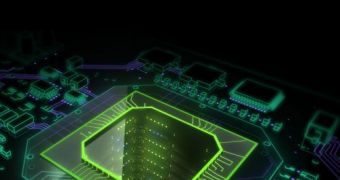The Academy Awards have come and gone and, while the various winners show off their prizes at parties and public events, NVIDIA is proudly announcing that its graphics technology was used in all the films nominated for the Academy Award for Visual Effects. All three nominees strove to bring an unprecedented level of realism and sophistication and, thus, had to rely on high-performance graphics technologies in order to perform such virtual tasks as the demolition of planets, real-time visualizations and complex graphical computations.
This year's three nominees for the Visual Effects Oscar were Star Trek, District 9 and, of course, the winner, Avatar. For the first of these three, Industrial Light & Magic (ILM), based in San Francisco, produced 850 of the roughly 1,000 shots and used NVIDIA Quadro FX 5800 on all of its workstations.
“This project marked our most ambitious effort on a 'Star Trek' film to date. We tapped the iconic references from the series and previous films and really took them to the next level driven by J.J. Abrams’ creative vision,” Michael DiComo, ILM Digital Production supervisor, said. “Our teams at ILM have established a solid development partnership with NVIDIA to help move the boundaries of visual effects technology to the next level. In the facility, there is an NVIDIA Quadro FX 5800 card sitting on each of our top end workstations to provide the kind of real time visualizations of the high-fidelity and very complex level of work that a film like ‘Star Trek’ demands.”
Quadro cards were also employed by Image Engine Design Inc. of Vancouver, British Columbia, Canada (leading visual effects provider for District 9), as well as by Weta Digital Ltd., of Wellington, New Zealand (primary visual effects vendor for “Avatar”). The latter paired the use of Quadro with NVIDIA Tesla solutions in its VFX (visual effects) production pipeline.
“The decision to standardize on NVIDIA Quadro graphics for ‘District 9’ and other film projects was very simple−they just work really well,” B. Terry Bates, head of systems, Image Engine, shared.
“We needed to think about rendering in a completely different way, given the complexity of ‘Avatar’,” Sebastian Sylwan, Weta’s head of research and development, said. “By working together with NVIDIA, we found a way to render incredibly sophisticated scenes in far less time, giving artists the critical ability to freely experiment with different lighting and iterate faster.”
Naturally, NVIDIA is quite proud of its hardware having been behind the production of these leading titles, feeling that its technology was a strong factor in the box-office records and evolution of the movie industry as a whole.
“The intricate and immersive computer generated worlds created by this year’s visual effects nominees have amazed theater goers and shattered box-office records. While we don’t know who will take home the Oscar, we do know that NVIDIA is honored to partner with all of them. The Embassy VFX, ILM, Image Design, and Weta Digital challenge us to create technologies that, in turn, enable them to evolve their craft in ways we could never imagine.”

 14 DAY TRIAL //
14 DAY TRIAL //